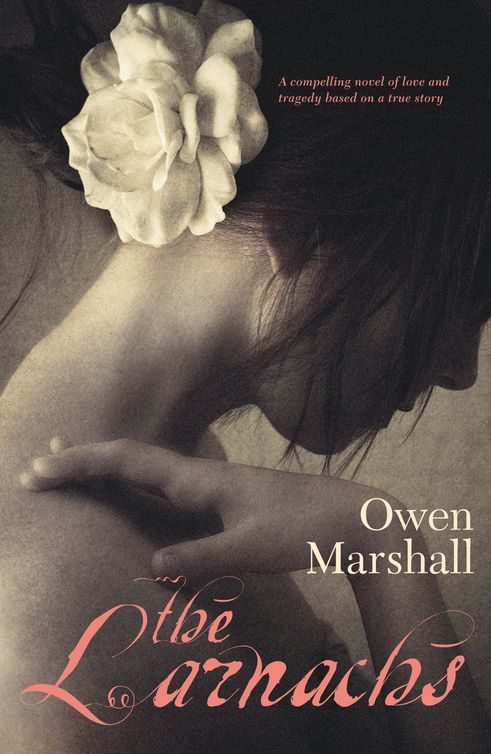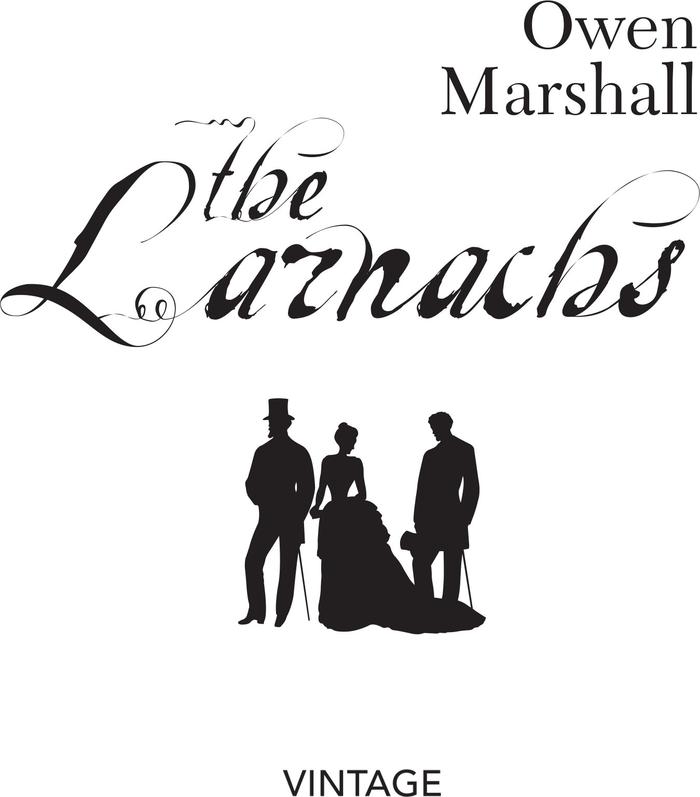The Larnachs
Authors: Owen Marshall



For William, Lydia, Sophie and Christian

This is not a biography and not a history.
It is a novel: the imaginative interpretation of a situation experienced by real people.

M
y chief source of family material was
King of the Castle
:
A Biography of William Larnach
by Fleur Snedden (David Bateman, 1997),
great-great
-granddaughter of William Larnach. She in turn acknowledges Hardwicke Knight’s
The Ordeal of William Larnach
(Allied Press, 1981).
I am grateful to Michelanne Forster for generously allowing me to read material she gathered in the course of writing her successful play,
Larnach
, and to Joanna Woods for her book
Facing the Music: Charles Baeyertz and the Triad
(Otago University Press, 2008), which contains much concerning the musical tastes of the period.
Other material is taken from the letter books of W.J.M. Larnach 1884–1898, held on microfilm in Dunedin’s Hocken Collections, and from contemporary newspaper reports.
I am grateful, too, for the encouragement and support of my editor, Anna Rogers, and publisher, Harriet Allan.
One’s real life is often the life that one does not lead.
—
Oscar Wilde

William James Mudie Larnach (1833–1898)
married Eliza Jane Guise (1842–1880) in 1859

Donald Guise (1860–1910)
Kate Emily (1862–1891)
Douglas John (1863–1949)
Colleen Shawn (1865–1951)
Alice Jane (1868–1942)
Gladys Beryl (1878–1900)
married Mary Cockburn Alleyne (1849–1887), half-sister to Eliza Guise, in 1882
married Constance de Bathe Brandon (1856–1942) in 1891
Alfred de Bathe Brandon (1809–1886)
married Constance Mary Anne Brandon (no relation, d. 1841) in 1840

Henry Eustace (1840–1886)
married Lucy Poole in 1854

Alfred (1854–1938)
Constance (1856–1942)
Charles (1860–1942)
Sarah
Fanny
Annie
Hugh (1868–1923)
T
he
Wellington Post
reports that the nuptials of the Hon. W.J.M. Larnach, C.M.G., and Miss Constance de Bathe Brandon, daughter of the late Hon. Alfred de B. Brandon, M.L.C., was solemnised in St. Paul’s Pro-cathedral this afternoon (January 27). The bride was attended by Misses F. and A. Brandon, her sisters, Misses F. and L. Brandon, the bride’s nieces, and Misses Doris Johnston and Cecilia Higginson. Dr Cahill acted as the bridegroom’s best man, and the bride was given away by her brother, Mr A. de B. Brandon. The ceremony was performed by the Rev. J.C. Andrew, M.A., assisted by the Rev. J. Still. There was a large congregation present, consisting principally of ladies, who naturally took a great interest in the affair. The wedding party, at the conclusion of the ceremony, returned to the residence of the mother of the bride, where a large number of family friends partook of an early afternoon tea. Mr and Mrs Larnach will spend their honeymoon on the West Coast of the North Island.
Otago Witness,
5 February 1891
C
onstance de Bathe Brandon married in summer. Curious people, mainly women, gathered in the sunlight and breeze outside the pale wooden walls of St Paul’s with its modest slate spire. The lawn was green and freshly mown, the small pohutukawa, still with a few last flowers, stood in close, dark foliage by the picket fence, beyond which carriage horses fidgeted. Thorndon Road dipped down towards Wellington Harbour, and steep, tree-stumped hills overlooked the city.
The interior of the Gothic church was dim because of the dark, native timbers — totara, matai, rimu and kauri — and the buttress arches rose to the high ceiling. As the guests waited, one man complained to his wife that it was like being inside a giant walnut, but the wonderful hues of the stained glass windows, especially the sapphire blue, shimmered in the gloom, and the Reverend Andrew’s white surplice and stole were richly tinctured by the colours cast. The guests witnessed Alfred give his sister away, although it was rumoured that he considered she was marrying someone rather beneath the family’s position. The bride’s voice, however, was clear and definite when she made her vows.
When the bridal party came from the cathedral, both those invited and the gawpers could make inventory of everything external: details of dress, deportment, the abundance of flowers, the quality of jewellery. Feelings were not so unequivocally displayed, although excitement showed on many female faces. Every marriage is a victory for women. It was a large wedding, socially significant, and most guests showed their pleasure in being included by slightly self-conscious poses as they stood around the
church front, and slight distraction in their conversations as they watched the wedded pair. Constance’s cream satin wedding dress was figured with sprigs of lily of the valley, and her pale jacket had a high collar and puffed sleeves. She wore flowers in her light brown hair, and her posture was very upright, her gaze direct. That she was small, neatly formed, was emphasised by the almost portly figure of the groom, an older man with drooping moustache and balding head, but considerable assurance none the less.
One woman observer, whose natural proportions made unnecessary the considerable bustle of her dress, commented that Dr Thomas Cahill, the best man, would make a more suitable husband for Constance, and also criticised the hairstyle of Cecilia Higginson, one of the bridesmaids, but most present responded to the occasion with affirmation and goodwill. Even more than a baptism, a marriage has a fine sense of optimism, for it is a conscious coming together of two people who consider a partnership better than individual selfishness.
The wind was strengthening across the harbour and up the slope to Thorndon. It stirred the train of the bride’s gown, and wafted a scrap of paper that startled a horse harnessed to the carriage waiting by Bishop’s Court to take the bridal party to the Brandon home. Two carriages were needed, in fact, for although Constance’s father was dead, she had three brothers and three sisters.
Davy Williams, who was to drive one carriage, moved closer to a skittish grey to quieten her, while still watching the people on the front church lawn, and talking with fellow driver Colm, who stood with his own two horses.
‘How long then d’you think we’ll be waiting here?’ asked Colm.
‘It’ll be a while, you’ll see. They’ll want to make the most of it.’
‘And when we get there we’ll be turned away without a decent meal, I dare say. Seems an odd pairing, don’t you think? He must have a good few years over her,’ said Colm. ‘Who the hell is Larnach anyway?’
‘That’s William Larnach,’ said Davy. ‘He’s a Parliament one just like her father used to be. Comes from way down south in Dunedin where it’s all Presbyterians and whisky.’
‘Me, I’ll have the bloody whisky and leave the Bible walloping.’
‘They say he’s married twice before and both died on him.’
‘Old goat.’
‘You’re right, but chance would be a fine thing, Colm boy.’
Perhaps some of their betters thought the same, but no indelicacy was expressed then among the guests of both sexes. It was all felicitations and admiration, all sharp observation of people who mattered on the day, especially, of course, Constance and Alfred de Bathe Brandon, and William Larnach, the happy groom. No one paid much attention to twenty-seven-year-old Douglas Larnach, who went forward awkwardly to kiss his stepmother after the ceremony.
The afternoon of 27 January 1891. A day as real and vivid as any other, before absorbed by the deepening mist of the past. A day of sunrise and sunset, of heightened significance for some, and routine boredom for most. A day of high ceremony, of mutton chop and potato dinners, of a specious land deal, the generosity of a patron, a long forgotten boy beaten with a razor strop for
soiling his britches, the reconciliation of elderly sisters, a murder on the gumfields, kindness and malice shown in a thousand homes and workplaces. A day, like all others, that held the possibility of advantage and misfortune. The day on which Alfred de Bathe Brandon, in place of his dead father, and displaying a manner that was to serve him well as mayor of Wellington, gave his sister in marriage to William James Mudie Larnach, self-made successful businessman, landowner and politician.
Conny, William and Dougie. There they are: alive, guiltless and smiling in the sunlight and the sea wind, with no shadows of the future cast over them, and choices still to be made. There they are, sharp and three-dimensional on the fabric of the present.